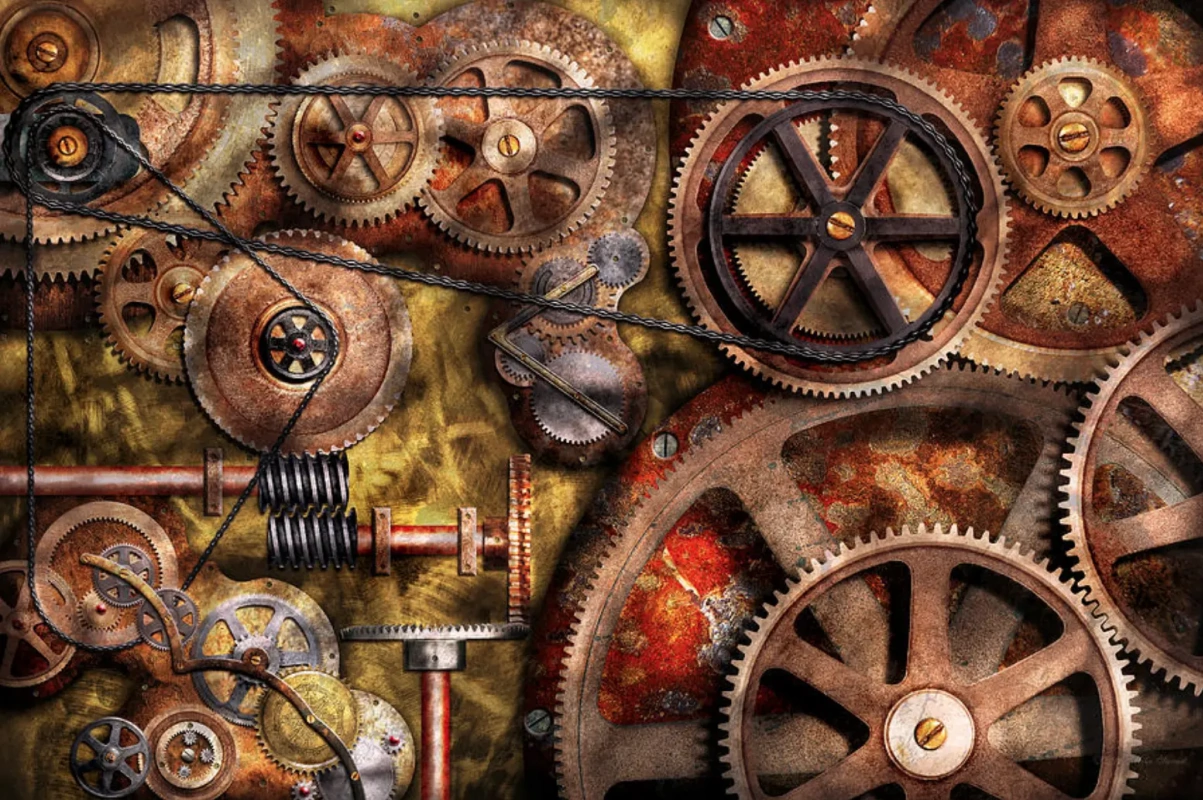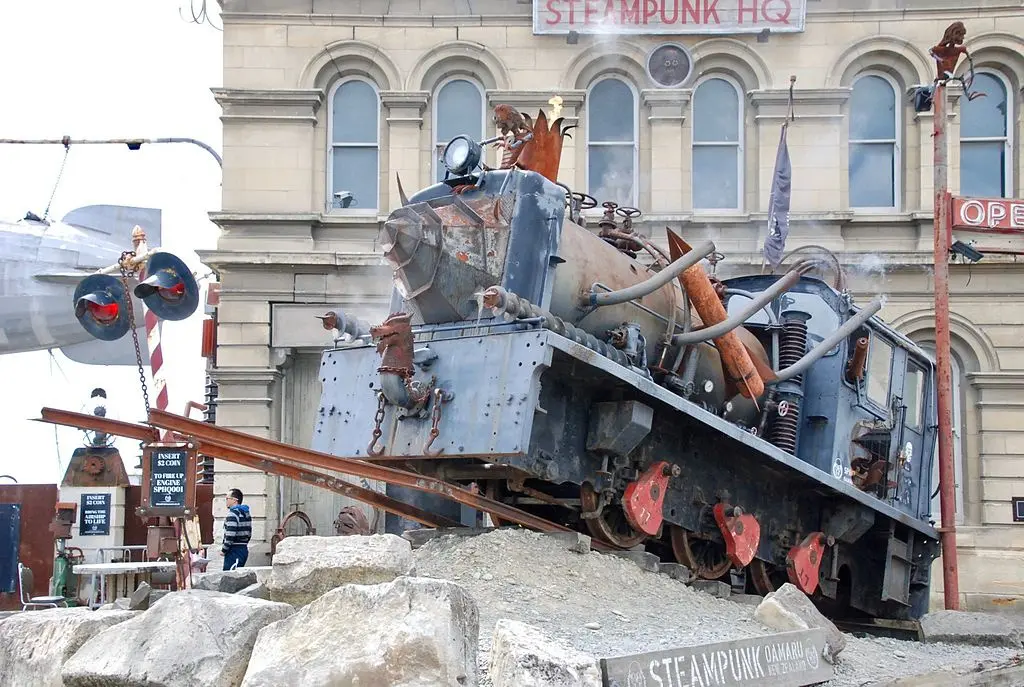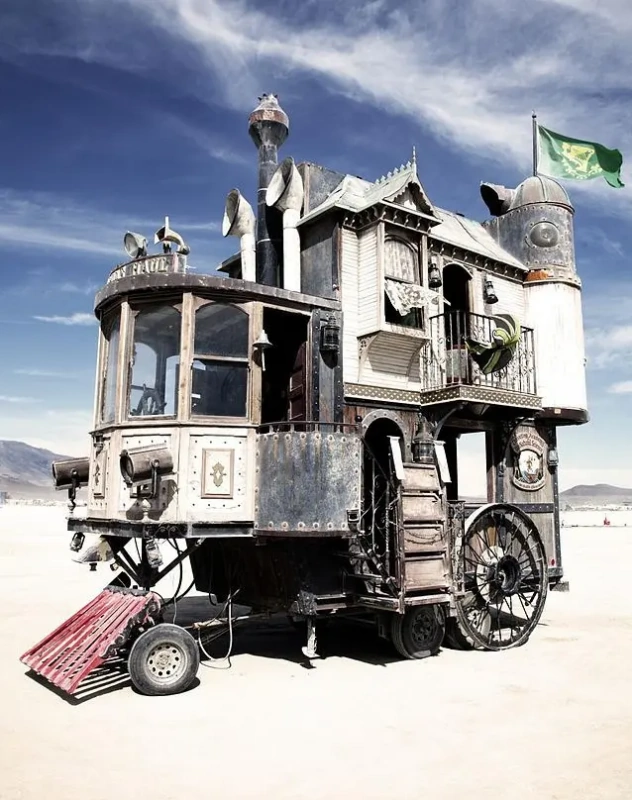Steampunk is one of the brightest representatives of the retro-futuristic branch of science fiction. Initially it emerged as a subgenre of literature, but later it has quickly spread beyond literary borders, turned into a separate subculture, and now the term is mostly used in design.

Where did steampunk come from?
Imagine that at a certain point in history, humanity has made a small turn in an unfamiliar direction, which made the modern world look completely different. Electricity has never replaced steam power. Plastic never appeared. People are still dressed in fancy outfits, such as vests with watch chains hanging from their pockets. This is the world that steampunk lovers imagine.This style emerged in the 1970s in literature as a subgenre of science fiction. Steampunk novels have described a kind of alternate reality in which Victorian fashion and technology continues to dominate the modern world. For example, a character in such a book can wear outfits from the second half of the 19th century, but at the same time live in the present time (or even in the future) and use cars and computers. Except that they would be set in motion by gearwheels and steam.

A Trip to the Theatre. Author: Pete Amachree
Steampunk: source of inspiration, genres, philosophy
Jules Verne and H. G. Wells were the main inspirers for steampunk novels. The famous novels Dracula by Bram Stoker and Frankenstein or Modern Prometheus by Mary Shelley, among others, became iconic for the entire steampunk movement. However, the so-called "penny novels" of the 19th century, mainly love and adventure novels, served as an equally important source of inspiration for the writers.Over time, steampunk has gone far beyond literature alone. Now it is mostly a style in the visual arts and design. Many steampunk fans consider it more of a lifestyle, even a worldview. The steampunk philosophy combines the optimism of the Victorian era with modern creativity and self-confidence. There are dozens of artists around the world who modify or create objects within the steampunk aesthetic. Some of the objects have practical applications, others are works of art or serve as part of a costume.

The interior of the Truth Coffee steampunk coffee shop in Cape Town
Japanese steampunk
In the Land of the Rising Sun, steampunk is no less popular than in Europe and the United States. Moreover, in Japan, the development and peak of this style took place at the same time as in other countries. Steampunk manga and anime, just like in Europe, arose under the influence of 19th century literature, and the Japanese fascination with an imaginary fantasy version of old industrial Europe, associated with the so-called "Paris syndrome", played a decisive role. Approximately in the same way as Europe was once carried away by the "exotic" Orient.Steampunk elements have consistently appeared in mainstream manga since the 1940s, starting with Osamu Tezuka’s sci-fi trilogy Lost World, Metropolis and Next World. Quite naturally, this style eventually penetrated into anime. Perhaps the most influential animator of this style is the famous Hayao Miyazaki, who has been creating steampunk anime since the 1970s. His manga Nausicaä of the Valley of the Wind and its 1984 anime adaptation already contained elements of this style, but fans of steampunk consider the most important work by Miyazaki to be Laputa Heavenly Castle. Here you can find such archetypical elements of the style as airships, hijackers, steam robots and the idea of steam energy as a limitless but dangerous source.

A still from the Nausicaä of the Valley of the Winds anime
Hayao Miyazaki’s work inspired director Hideaki Anno and Gainax Studio to create one of the most famous and iconic steampunk anime, Nadia: The Secret of Blue Water. This series was a free adaptation of the Twenty Thousand Leagues Under the Sea by Jules Verne and the image of Captain Nemo himself. Nadia has influenced many later anime and cartoons, including Disney’s Atlantis: The Lost World. Hayao Miyazaki, who used elements of this style in his two more iconic works, Porco Rosso (1992) and Howl’s Moving Castle (2004), did not stop turning to steampunk.

A still from the Howl’s Moving Castle anime
Fine arts and design
Among the pioneers of steampunk in the visual arts is the Spanish-Mexican artist Remedios Varo, although she passed away ten years before the term "steampunk" appeared. In her surreal works, the artist combined elements of Victorian outfits, fantasy and techno fantasy.
Omo Rodan
1959, 80×58 cm
Many modern steampunk visualisations have their origins, among others, in the 1954 Walt Disney film 20,000 Leagues Under the Sea and in George Pal’s The Time Machine (1960), based on the book by H. G. Wells. One of the most striking examples of steampunk in popular culture is the League of Extraordinary Gentlemen comics series (as well as its adaptation of 2003 — not very successful, albeit spectacular). Each issue contained dozens of Victorian literary references. For example, among the main characters of the League are Captain Nemo, Mina Harker from Dracula by Bram Stoker, Dr. Jekyll, Allan Quatermain from King Solomon’s Mines and the Invisible Man.

Steampunk version of The Wizard of Oz. Author: Justin Gerard
Steampunk in the cinema
As a visual style, steampunk is very cinematic in its nature. There are a large number of films inspired by the style aesthetics, including film adaptations of the books by Jules Verne and Herbert G. Wells. Mention just the Wild, Wild West movie (1999) with Will Smith and Kenneth Branagh, which blended steampunk into the genre of westerns unexpectedly, but quite organically. The film almost failed at the box office and was crushed by critics, but it inspired fans of the style to new modifications. And the giant mechanical spider later appeared in one of episodes of The Simpsons series, which can be considered some form of recognition of its importance.
Gears of Time. Author: Majentta
Peter Jackson, director of Tolkien’s The Lord of the Rings and The Hobbit, also paid tribute to the steampunk aesthetic with The Chronicles of Predatory Cities. It was the visual part that turned out to be the main advantage of the film, based on the novel by Philip Reeve.
Steampunk in design
In design, the main aspect of steampunk is the balance between form and function, which in some ways makes it related to the Arts and Crafts artistic movement of the late 19th century. However, while John Ruskin, William Morris, and others in the movement rejected industrial production in general, steampunk aficionados are more likely to advocate a "non-luddite critique of technology". In addition to creating original art and design, steampunk enthusiasts are modifying modern utilitarian objects like computer keyboards and electric guitars in a pseudo-Victorian style. Rejecting the aesthetics of industrial design, such craftsmen create unique objects (without losing their functionality) using brass, iron, wood and leather.
Glowing table clock by German master Frank Buchwald
In recent decades, steampunk has been mostly used in the small form design — from household items to jewellery. However, there are several objects in this style that are striking in their size. For example, the Arts et Métiers subway station in Paris, which was decorated in 1994 by Belgian artist François Schuiten in the steampunk style in honour of the iconic works by Jules Verne, and now it looks like a huge submarine sheathed in copper with giant gears and portholes.

Arts et Métiers station
Objects in this style (including those with steam engines) often appear at the famous Burning Man festival. In Oamaru, New Zealand, there is the Steampunk HQ Gallery (located in the historic Victorian neighbourhood of the city), which contains a huge variety of ingenious gadgets and sculptures, complemented by audiovisual installations. A giant locomotive is installed outside the building, which produces the sounds of a steam locomotive, and releases steam and fire from its chimney.
Of particular note is the project by artist François Delarozière, artistic director and creative force behind La Machine, a theatre company specializing in street shows featuring giant mechanized "performers", such as moving and often fire-breathing characters from an elephant and a spider to the Minotaur, rendered in steampunk style. Technicians and designers are an important part of the project.
Title illustration: Mike Savad
我们建议阅读






















